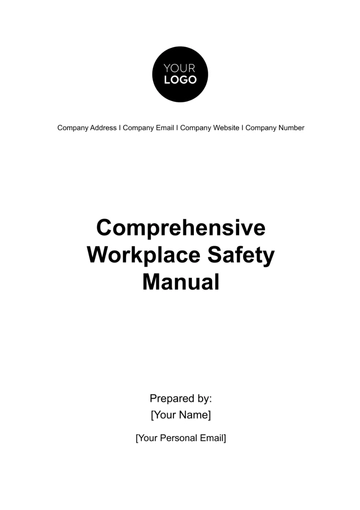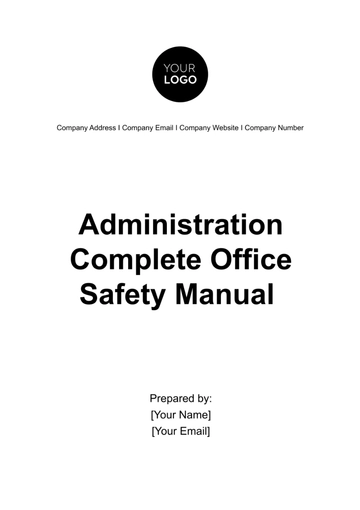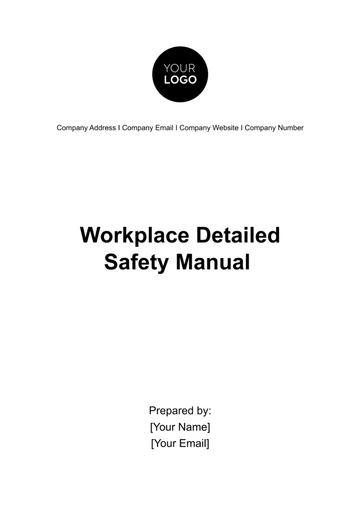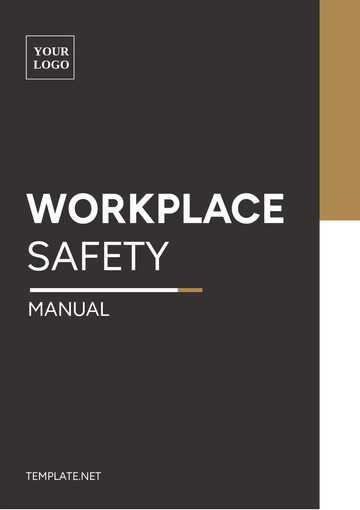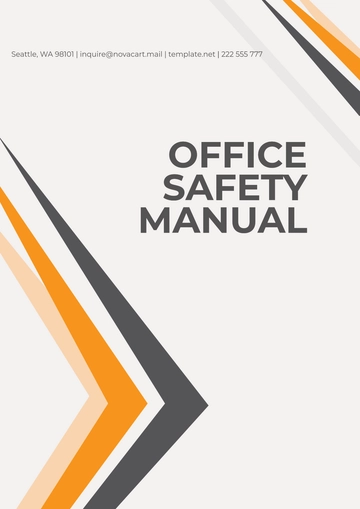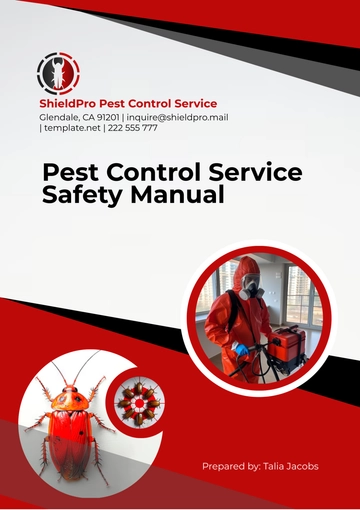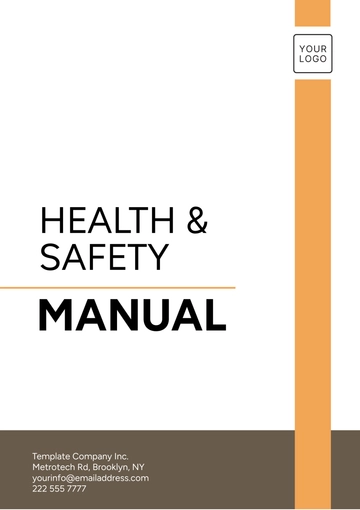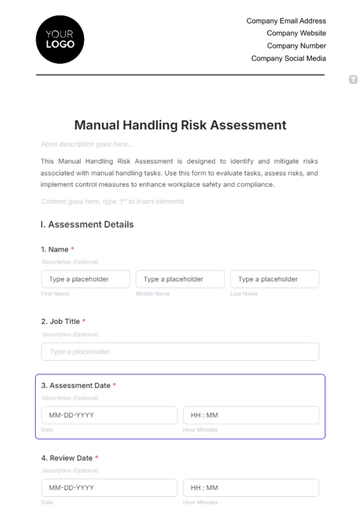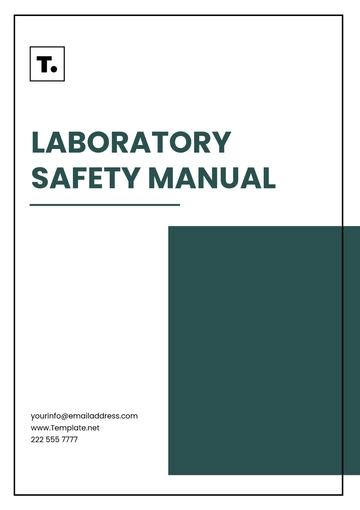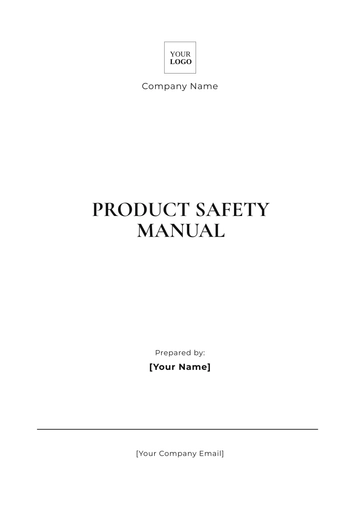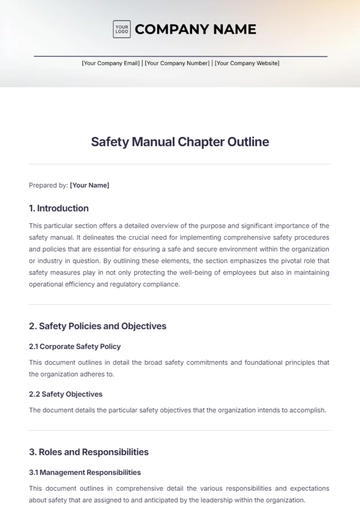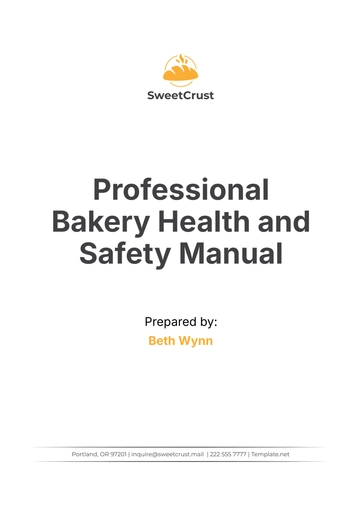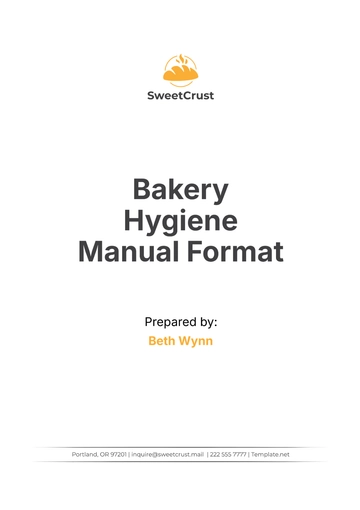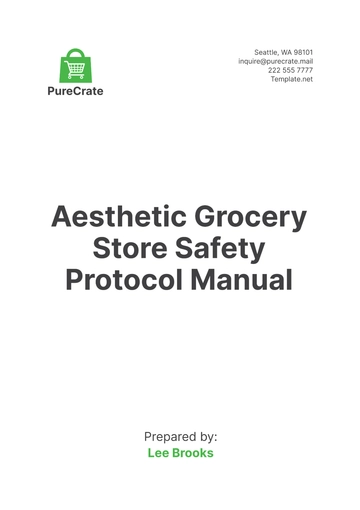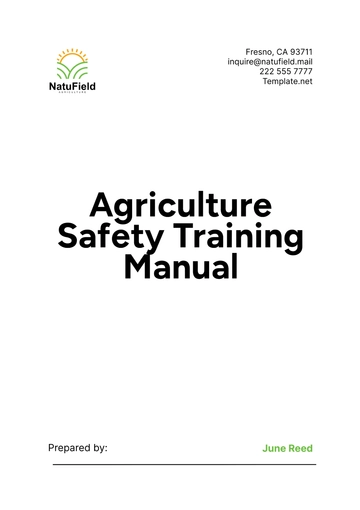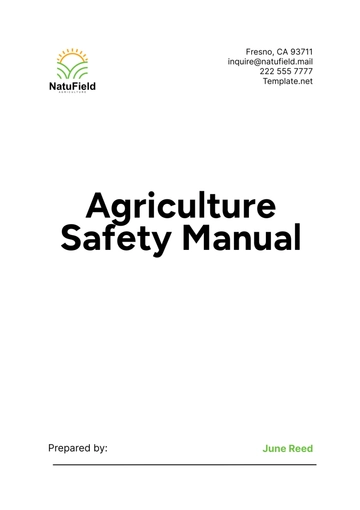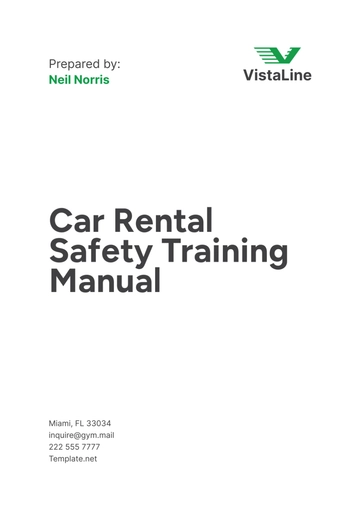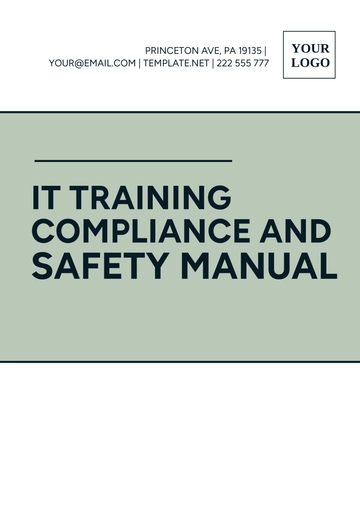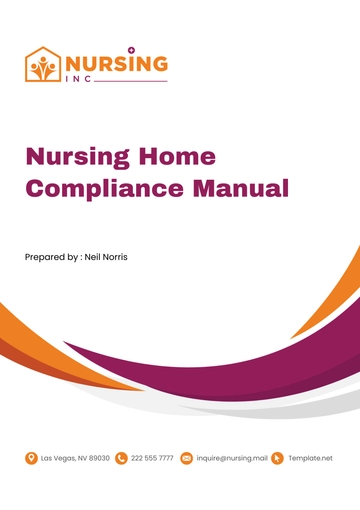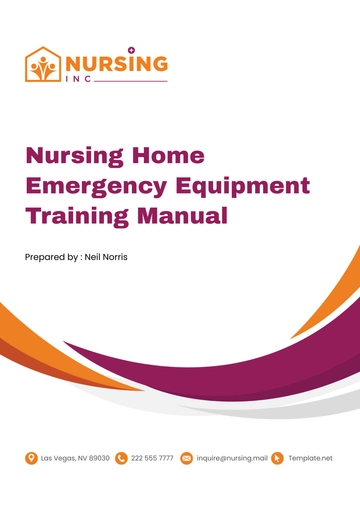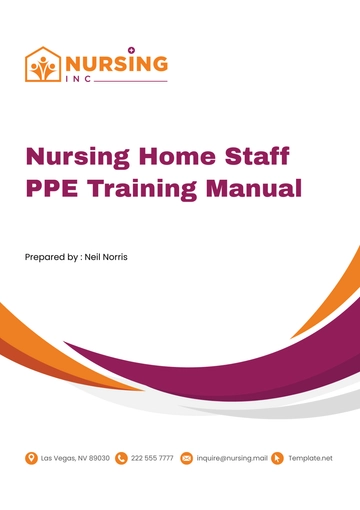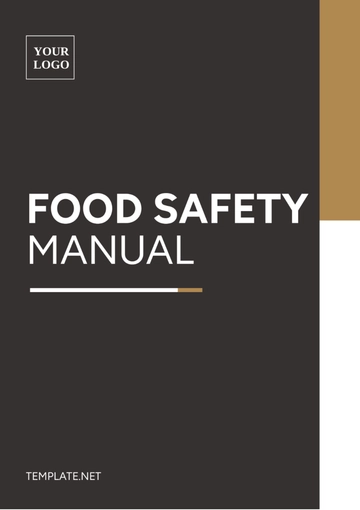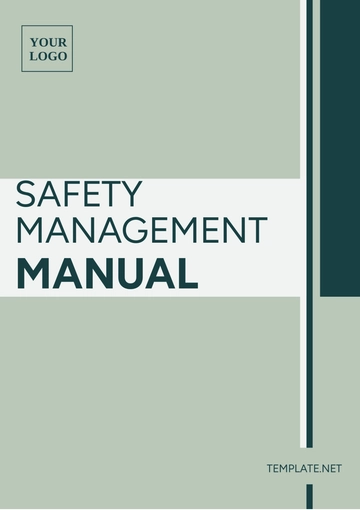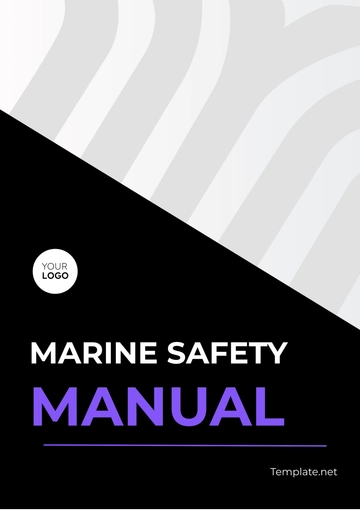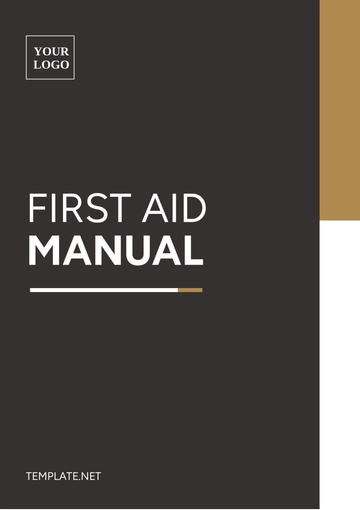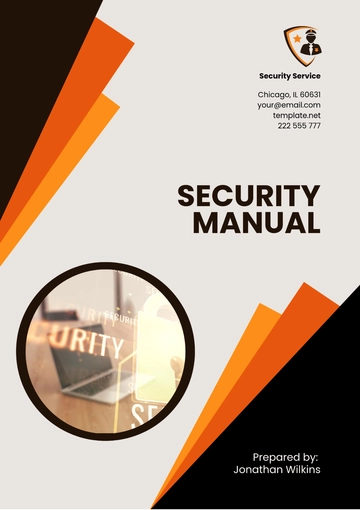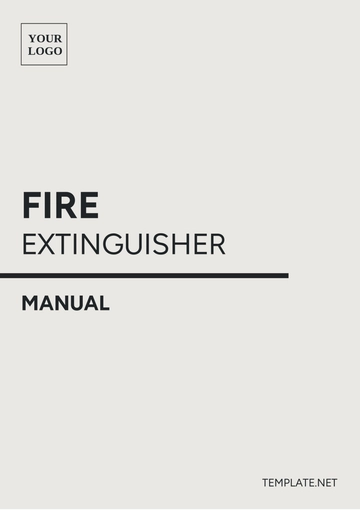Free Comprehensive Workplace Safety Manual HR
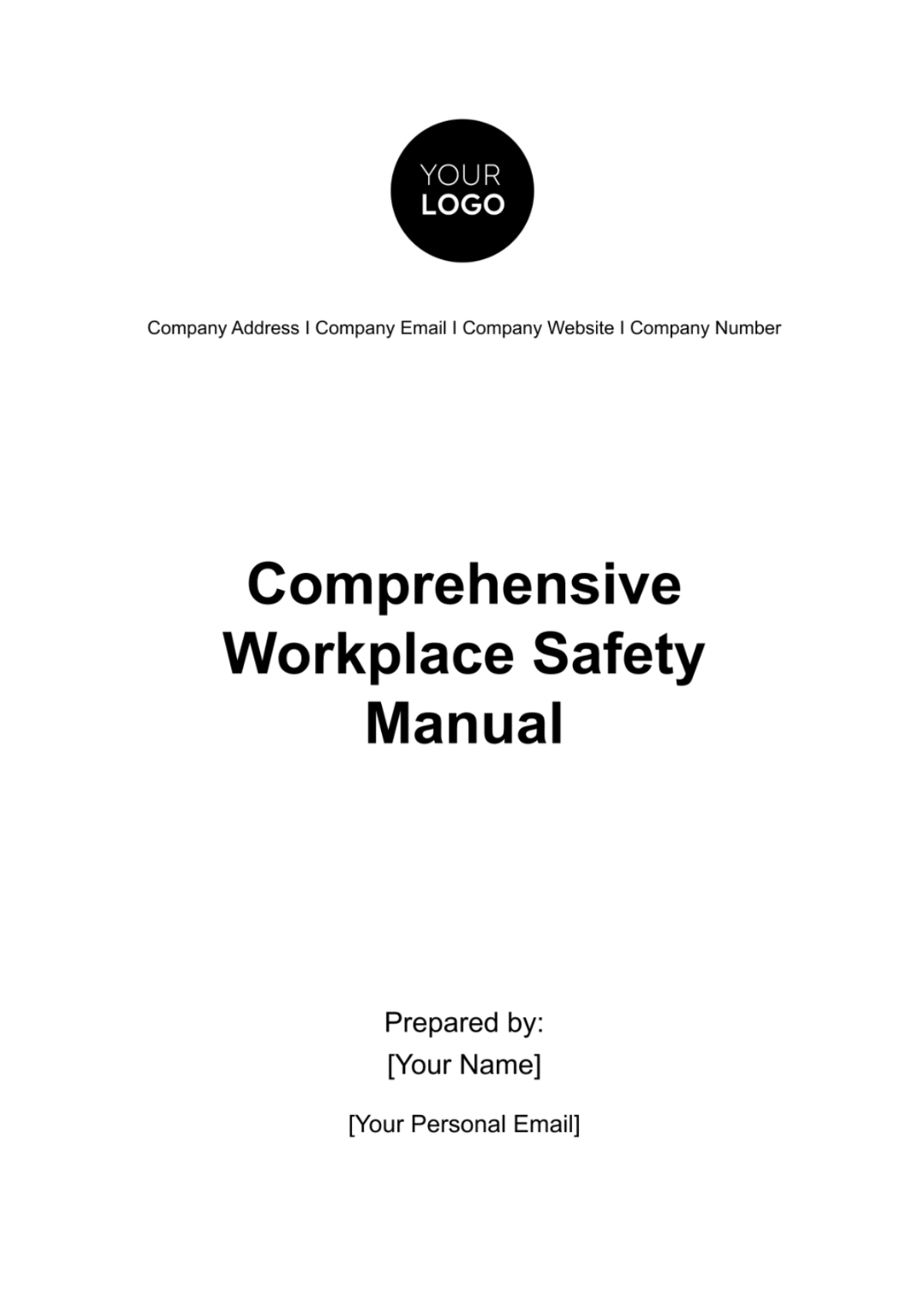
Introduction
Welcome to [Your Company Name]'s Workplace Safety Manual. This document serves as a foundational guide to ensuring the well-being of all our employees. Our top priority is the health and safety of our team, and we understand that a strong safety culture not only benefits our employees but also contributes to our business's overall success.
Our Safety Commitment:
Prioritize Employee Safety: The health and safety of our employees is non-negotiable. Every decision we make, from company policies to daily operations, factors in the welfare of our team.
Continuous Improvement: We vow to continuously review and enhance our safety protocols. This means always being on the lookout for new information, tools, and best practices to implement.
Engage and Educate: We believe that safety is a collective responsibility. We commit to involving all employees in safety discussions, training sessions, and feedback loops.
Our safety manual is not just a collection of rules and guidelines. It's a testament to our dedication to creating a safe, supportive, and productive environment for every member of the [Your Company Name] family.
General Safety Guidelines
At [Your Company Name], safety is an integral aspect of our daily operations. Adherence to the following guidelines ensures not just individual safety, but also creates a harmonious and hazard-free working environment for everyone.
Situational Awareness: Always be aware of your surroundings. This means understanding the workflow of your area, knowing who is around you, and being conscious of any potential hazards.
Clear Pathways: Ensure walkways, corridors, and common areas are free from clutter and obstructions. This prevents tripping hazards and ensures quick evacuation in emergencies.
Adherence to Safety Signage: Safety signs are there for a reason. Observe all posted safety signs, instructions, and protocols. If you notice a missing or damaged sign, report it immediately.
Machinery and Tools Protocol: Use machinery and tools strictly as they were intended and only after proper training. Regularly inspect equipment for wear and tear. Immediately report any malfunction or suspicious behavior of machinery to the concerned department.
Avoid Distractions: When handling machinery or engaging in tasks that require concentration, avoid distractions such as mobile phones, unnecessary conversations, or any other activities that might divert your attention.
Safe Lifting Techniques: If your job requires lifting objects, always bend at the knees and keep the load close to your body. Avoid twisting or turning while lifting and seek help for heavy or awkward items.
Hygiene and Cleanliness: Regularly wash your hands, especially after handling potentially hazardous materials or machinery. Keep your workspace clean and organized, as this not only reduces the risk of accidents but also boosts productivity.
Use of Personal Devices: Ensure that the use of personal devices, like phones or tablets, does not jeopardize your safety or the safety of those around you. It's essential to remain alert, especially in areas with moving equipment or high pedestrian traffic.
Remember, safety isn't just the responsibility of the management or the safety officer. Every individual at [Your Company Name] plays a crucial role in ensuring a safe working environment. It's our collective duty to look out for one another and uphold the highest safety standards.
Emergency Procedures
Emergencies can arise without warning, but with the right procedures in place, we can mitigate risks and ensure the safety of our [Your Company Name] family. The following guidelines provide clear steps to handle emergencies effectively and efficiently.
NUMBER 1) Know Your Exits: Familiarize yourself with all escape routes from your work area. These should be clearly marked and free from obstructions. Regularly check these paths to ensure that no blockages or hindrances have emerged over time.
NUMBER 2) Fire Safety: In the event of a fire:
Activate the nearest fire alarm.
Do not use elevators. Use the staircase instead.
Before opening a door, feel it. If it's hot, seek an alternate route.
If smoke is present, stay low to the ground.
Once outside, move to the designated assembly area and do not re-enter the building until given the all-clear signal.
NUMBER 3) Regular Drills: Participate in all scheduled fire, evacuation, and other emergency drills. These are crucial for familiarizing staff with procedures and ensuring quick and orderly responses during real emergencies.
NUMBER 4) First Aid: Know the location of the nearest first aid kit and be familiar with basic first aid procedures. Consider enrolling in a first aid course if one is available.
NUMBER 5) Shelter in Place: In certain emergencies, such as extreme weather events or hazardous material releases, it might be safer to remain indoors. Familiarize yourself with the designated shelter areas in the building and the procedures to follow.
NUMBER 6) Communication: In all emergencies, clear and calm communication is key. Familiarize yourself with [Your Company Name]'s emergency communication systems, whether it's an intercom, a PA system, or a specific emergency hotline.
NUMBER 7) Emergency Contacts: Maintain an updated list of emergency contact numbers, both personal and for official services (fire, police, medical). This list should be easily accessible, ideally both as a physical copy and digitally.
NUMBER 8) Reporting: After the immediate emergency has passed, always fill out an emergency incident report. This helps in analyzing the situation, understanding what went right or wrong, and making improvements for the future.
Preparedness is half the battle in emergencies. By familiarizing ourselves with these procedures and regularly revisiting and practicing them, we not only protect ourselves but also play a part in safeguarding our colleagues and the broader [Your Company Name] community.
Hazard Identification and Reporting
Proactively identifying and reporting hazards is fundamental to the creation of a safe work environment at [Your Company Name]. By recognizing potential dangers and acting promptly, we can prevent accidents, injuries, and disruptions. This section details the steps and considerations vital for effective hazard management.
Step/Process | Details |
|---|---|
Proactive Observation | Cultivate a vigilant mindset. Whether you're in your regular workspace, a communal area, or a different department, be alert to abnormalities or potential dangers. This includes wet floors, frayed wires, misplaced tools, or improperly stored chemicals. |
Immediate Action | If you can safely rectify a minor hazard (like wiping up a spill), do so immediately. However, never put yourself at unnecessary risk. If the hazard is significant or if you're uncertain about the proper course of action, prioritize reporting over intervention. |
Use of Hazard Report Form | Clearly describe the identified hazard and specify the location and time of observation. You must also indicate if any immediate actions were taken. After that, please submit the form to your direct supervisor and the safety committee. |
Feedback Loop | After submitting a hazard report, you should receive feedback. This might include measures taken, further steps required, or recommendations for avoiding similar hazards in the future. |
Routine Inspections | Supervisors and designated safety officers should conduct regular workplace inspections to identify and address potential risks proactively. This not only ensures a safer environment but also encourages a culture of vigilance and responsibility. |
Encourage Open Dialogue | [Your Company Name] values the insights and experiences of its employees. Regular safety meetings should be held to discuss and address concerns. An environment where employees feel comfortable speaking up about potential hazards is vital. |
Confidentiality | If, for any reason, an employee wishes to report a hazard anonymously, provisions should be in place to ensure their concerns are heard without revealing their identity. |
Incentivizing Reporting | Consider implementing a system to reward those who consistently identify and report potential hazards. Recognizing these contributions emphasizes the importance of proactive safety measures and encourages a company-wide safety mindset. |
Through collective vigilance and immediate action, we can maintain a work environment that prioritizes the safety and well-being of every individual at [Your Company Name]. The process of identifying and reporting hazards is not just a procedural necessity; it's a testament to our commitment to each other and the values we uphold.
Protective Equipment
The use of protective equipment is not merely a formality—it's a responsibility we hold towards ourselves and our colleagues. Protective equipment acts as a barrier between potential hazards and our health, ensuring that we can perform our tasks safely and effectively. This section delves into the guidelines and best practices surrounding the use, maintenance, and importance of protective equipment.
Appropriateness for Task: Ensure that you are using the correct protective equipment for the task at hand. What might be suitable for one job might not be for another. For instance, welding requires a different set of protective gear compared to handling chemicals.
Proper Fit: Protective equipment should fit correctly. Ill-fitting equipment can be as dangerous as not wearing any protection at all. Always ensure that helmets, gloves, goggles, and other items are of the appropriate size and adjusted properly.
Regular Inspection: Before using any protective gear, give it a quick inspection. Check for signs of wear and tear, such as cracks in goggles, thinning gloves, or compromised seals on masks. Report and replace any equipment that appears damaged.
Training: Familiarize yourself with the correct methods to wear, adjust, and remove protective equipment. Misusing or incorrectly wearing protective gear can diminish its effectiveness.
Maintenance and Storage: After using protective equipment, clean and store it as per guidelines. This prolongs the life of the equipment and ensures it remains effective. For instance, dust masks should be stored in a sealed bag to prevent contamination.
Avoid Sharing: Whenever possible, avoid sharing protective equipment, especially those that are close-fitting or come in contact with the face. This reduces the spread of germs and ensures a proper fit for each user.
Stay Updated: Periodically, there may be updates or recalls on protective equipment. Stay informed about these changes and ensure that any compromised gear is replaced promptly.
Feedback System: If you encounter any discomfort, difficulty, or identify potential improvements in the protective equipment provided, communicate these observations. Feedback can lead to the provision of better-fitted or more comfortable gear, enhancing safety and comfort for everyone.
Respect for Equipment: Recognize that protective equipment is not just a mandatory requirement but a lifesaver. Treat it with respect, and understand its value in safeguarding your well-being.
By ensuring the appropriate use and care of protective equipment, we reinforce [Your Company Name]'s dedication to the safety of its staff. Every time we don our protective gear, we're making a statement about our commitment to a safer workplace and the well-being of our colleagues.
Safety Training and Education
We firmly believe that knowledge and education are the cornerstones of a safe working environment. This section details our approach, guidelines, and expectations regarding safety training and education.
Training Category | Details |
|---|---|
Mandatory Induction Training | Every new employee, regardless of their role, will undergo an initial safety induction training. This ensures that from day one, they are aware of the company's safety culture, protocols, and expectations. |
Specialized Training | Depending on the role and tasks performed, employees may need specific training sessions. Whether it's operating a piece of machinery, handling chemicals, or first aid, specialized training equips employees with the skill set tailored for their duties. |
Refresher Courses | Safety guidelines and best practices evolve over time. Regular refresher courses ensure that all staff members are up-to-date with the latest safety standards and protocols. |
Interactive Workshops | Instead of traditional lectures, consider hosting interactive workshops where employees can participate in hands-on activities, simulations, and discussions. This fosters better understanding and retention. |
Digital Resources | Make use of technology by creating a digital safety library. Include videos, e-books, case studies, and interactive modules that employees can access anytime for learning or refresher purposes. |
Safety training and education are not just about ticking boxes or meeting regulatory requirements. They are a testament to [Your Company Name]'s dedication to the well-being of its employees. By investing in the knowledge and skills of our team, we pave the way for a safer, more informed, and more resilient workplace.
Periodic Safety Audits and Reviews
Periodic safety audits and reviews provide an objective overview of our safety practices, ensuring they are robust and attuned to the ever-evolving dynamics of our workplace. This section outlines our approach to these audits and reviews.
Scheduled Audits: All departments and work areas will undergo comprehensive safety audits at scheduled intervals. This systematic and structured evaluation ensures that no aspect of our operations is overlooked in our pursuit of safety excellence.
Audit Teams: Audits should be conducted by a mix of internal safety experts and, when appropriate, external professionals. This mix provides a blend of company-specific knowledge and an external, unbiased perspective.
Safety Metrics: During audits, specific safety metrics will be evaluated to gauge the effectiveness of our safety protocols. This might include data on incident rates, near misses, hazard reports, and safety training attendance.
Feedback Mechanism: Post-audit, there will be a feedback session where audit findings are discussed with the concerned departments. This is a time for reflection, understanding, and planning corrective actions if required.
Review of Past Incidents: Every audit will include a review of incidents that occurred since the last audit. This deep dive will analyze the cause, response, and measures implemented post-incident, ensuring lessons are learned and not repeated.
Safety Innovation: Audits are not just about finding flaws. They also highlight areas where [Your Company Name] is leading in safety innovation. Identifying and promoting these practices can set new safety benchmarks for the entire industry.
Actionable Insights: The goal of every audit is to derive actionable insights. Whether it's tweaking a process, introducing new equipment, or reinforcing certain protocols, the audit's findings should directly inform tangible improvements.
Regular safety audits and reviews ensure that our commitment to safety doesn't become complacent over time. By consistently assessing and fine-tuning our practices, we reinforce our dedication to the well-being of every individual at [Your Company Name] and ensure that our safety standards remain at the pinnacle of excellence.
Incident Reporting and Investigation
Every incident, no matter how minor, offers valuable insights into potential gaps in our safety protocols and provides opportunities for improvement. This section elaborates on our procedures and principles surrounding incident reporting and subsequent investigation.
Immediate Reporting: Any incident, from near misses to injuries or damage to property, should be reported immediately to the concerned supervisor or safety officer. Early reporting can prevent escalation and helps in swift remediation.
Investigation Team: Depending on the severity and nature of the incident, a dedicated team comprising safety officers, department heads, and, if necessary, external experts, will be formed to investigate.
Fact-Finding, Not Fault-Finding: The primary objective of the investigation is to understand the root cause of the incident, not to assign blame. A non-punitive approach encourages transparency and full disclosure, which are essential for effective investigations.
Thorough Analysis: Use proven methodologies, such as the Root Cause Analysis (RCA), to break down the incident, identify underlying factors, and understand how similar incidents can be prevented in the future.
Documented Findings: Every stage of the investigation, from initial reports to final conclusions, will be meticulously documented. This serves as a record for future reference and training.
Recommendations and Implementation: The investigation should culminate in clear recommendations to address identified issues. These might include revising protocols, additional training, equipment modifications, or any other relevant measures. A timeline for implementing these changes should also be established.
Feedback Loop: Once the investigation concludes, findings and subsequent action plans should be communicated to relevant departments, ensuring everyone is informed and aligned.
Confidentiality: Respect the privacy of individuals involved in incidents. While transparency is crucial, sensitive details should only be shared on a need-to-know basis.
Conclusion
At [Your Company Name], we believe that a safe workplace is a productive workplace. Thank you for taking the time to review our safety manual. Together, we can make [Your Company Name] a safe environment for everyone.
- 100% Customizable, free editor
- Access 1 Million+ Templates, photo’s & graphics
- Download or share as a template
- Click and replace photos, graphics, text, backgrounds
- Resize, crop, AI write & more
- Access advanced editor
Safety first, and always prioritize life over results! With Template.net's Comprehensive Workplace Safety Manual HR Template, you’ll have an editable and fully customizable cornerstone document template blueprint that can help outline protocols, best practices, and standards to ensure a secure and hazard-free work environment for all. Start editing it now with our Ai Editor Tool only at Template.net.
